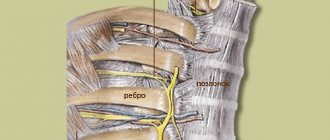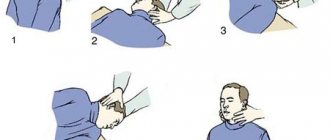What is intercostal neuralgia?
Let's start with the fact that intercostal neuralgia is not a disease.
This is the name for pain that occurs when the intercostal nerves are exposed to various pathological factors, for example, herpetic infection, tumors, injuries, disc herniation, protrusion, osteochondrosis, etc. In other words, thoracic intercostal neuralgia can be called not all chest pain, but only that where intercostal nerves are involved. And this needs to be clearly understood so that the confusion that you often encounter at the everyday level does not arise when you hear people using the term intercostal neuralgia, but at the same time they mean a completely different pathology. By the way, even some doctors sometimes make the diagnosis of intercostal neuralgia erroneously, while in reality it most often turns out to be myofascial syndrome. Intercostal neuralgia, myalgia, myositis, myofascial syndrome, osteochondrosis, disc herniation, protrusion and many other terms are not synonymous. These are the names of specific pathologies that have their own characteristics and differences. And, since they are different, it means that the approach to them must also be different, otherwise there will be no sense in the treatment.
In general, the term intercostal neuralgia should not be used haphazardly, and it is not worth calling all pain in this area that way.
Intercostal neuralgia in women & Intercostal neuralgia in men.
Intercostal neuralgia in men occurs as often as in women, but at the same time, intercostal neuralgia in women has its own characteristics. For example, women often perceive pain due to intercostal neuralgia as a manifestation of breast disease, and not as neuralgia. And it is clear that such thoughts can only cause additional anxiety and worry. But there is one consolation - although pathology of the mammary glands is indeed common, even if it is present, the vast majority of pain is not associated with it, but with the spine, nerves and muscles. This does not cancel periodic examinations with a mammologist, but it does mean that you should never panic. And most importantly, keep in mind that in medicine there is such a concept - a disease “in disguise”, when one disease is masked by another. Let's look at the insidiousness of this problem using our example. Pathology of the mammary glands is a psychological dominant that causes much more concern than intercostal neuralgia. Accordingly, if a woman simultaneously has thoracic intercostal neuralgia and pathology of the mammary glands, then all her thoughts will be focused on the glands. The rest will fade into the background. And it is quite natural that in this situation a woman, first of all, will turn to a mammologist. If the mammologist turns out to be knowledgeable, he will quickly figure out what is causing the pain: glands or neuralgia. And, if it is neuralgia, he will refer the patient to a chiropractor. By the way, it is the chiropractor who is the main doctor for intercostal neuralgia (but we’ll talk about this later). And if a mammologist comes across an inexperienced or over-insurer, what will he do? Most likely, having discovered his own profile pathology in the patient, he will also focus on this pathology and will not “dig” deeper. Consequently, if in reality the patient was bothered by pain due to intercostal neuralgia, and the pathology of the mammary glands was only a background that did not cause pain, then treatment by a mammologist will not solve the problem. The pain will remain. And this will cause the woman even more anxiety. Her faith in doctors will suffer. Your nerves and time will be wasted. This is what the disease turns out to be “under the mask.” Meanwhile, intercostal neuralgia in women very often occurs under the guise of mammary gland pathology. Be sure to remember this!
Dear women, the best advice for pain in this area is to contact two specialists at once. A mammologist will give you confidence and relieve fears, and a chiropractor will cure intercostal neuralgia. After all, as we have already said, a chiropractor is the key doctor for intercostal neuralgia. This approach is the most reasonable. It will save you both time and nerves.
Intercostal neuralgia in men also has its own characteristics, and these are not always differences. For example, very similar psychological aspects. So, if in women intercostal neuralgia often occurs under the guise of mammary gland pathology, then in men it occurs under the guise of heart disease. By the way, it is precisely the “disguise” as heart disease that distinguishes left intercostal neuralgia from intercostal neuralgia on the right side. Do you know how to distinguish intercostal neuralgia from a heart attack at home? Very simple. Heart pain is relieved by nitroglycerin, but neuralgia is not.
According to statistics, intercostal neuralgia on the left in the heart area equally often causes a false alarm in both men and women. Moreover, in women, both the heart and the mammary gland come under suspicion. But, right intercostal neuralgia is “suspicious” only for women. Men immediately understand that this is intercostal neuralgia.
Treatment of intercostal neuralgia with folk remedies
Folk remedies for intercostal neuralgia can also complement therapy.
Their advantages are that they are safe and affordable , and in some cases they really help to achieve excellent results.
Among the disadvantages, it is worth noting that they do not give results immediately. In addition, many recipes include herbal ingredients that can provoke an allergic reaction. Despite all the safety of such products, they should still not be used without the permission of a specialist. .
Traditional medicine recipes for intercostal neuralgia
For this pathology, the following folk recipes have proven themselves to be effective::
- Salt compresses . Take a glass of hot water for a tablespoon of salt. A cloth is soaked in this solution and a compress is made, which is covered with a warm woolen cloth. You need to keep it for 2-3 hours. The point of the procedure is that the salt draws excess liquid onto itself, thereby relieving swelling. Taking into account the thickness of the skin on the back, the compress time can sometimes reach up to four hours.
- A mixture of horseradish juice and black radish , which is rubbed into the skin on the back, warms up well.
- Mix 1:1 iodine and glycerin , then lubricate the area where the pain is localized before going to bed. The main thing in this procedure is not to rub the product in or wrap it up.
- You can also rub in a mixture of natural turpentine gum and the same amount of Vaseline. Resin is the resin of coniferous trees.
- Shilajit also helps a lot . The infusion of mumiyo with alcohol should be rubbed into the sore spot. It is also taken orally, mixed with honey or milk (0.2-0.4 g per dose). You should take mumiyo either early in the morning or before bed.
- Another remedy that has proven itself is propolis . To treat neuralgia, you need to take a tablespoon of 20% propolis tincture, vegetable oil and honey. Mix everything and apply compresses to the affected area. They can be left overnight.
Medicinal baths may also be indicated . They are usually prescribed from the third day, when the acute pain subsides and movement is restored. The main danger of this procedure is that when you leave the bathroom, you risk hypothermia. It is better to take baths at night.
You can use the following options:
Pay attention to some recipes for medicinal baths for neuralgia in the costal area. Add 5 drops of mint, eucalyptus and lavender essential oils to the bath. Acceptance time is 10 minutes.- Bath with sage infusion. For 2-3 cups of boiling water, take 5 tablespoons of raw materials. It should brew for an hour, then you can go into the bath for 10-15 minutes.
- To improve sleep, a warm bath with a decoction based on the roots and rhizomes of valerian can be used. You need to take 100-200 grams of raw materials, prepare a decoction in accordance with the general rules, and let it brew for 30 minutes. The bath temperature should not be hotter than 39 degrees.
- Salt bath. The concentration should be similar to that of the sea. For a liter of water, take three grams of salt; for a bathtub with a volume of 180 liters you will need 540 grams of table salt. It is recommended to take a bath for 10-15 minutes.
Folk remedies can be an excellent addition to traditional therapy measures. But remember that in the case of them you also need to be careful.
Video: “The simplest method of treating intercostal neuralgia”
Symptoms of intercostal neuralgia
It is believed that the main symptom of intercostal neuralgia is pain in the intercostal space. But how can one distinguish intercostal neuralgia from one symptom, even such a striking one? After all, pain in the ribs also occurs with other pathologies. Obviously, for an accurate diagnosis, more signs of intercostal neuralgia are needed. Therefore, we decided to talk about the symptoms and causes of intercostal neuralgia in more detail.
The name intercostal nerves speaks for itself. They are actually located between the ribs. Starting from the spine, they cover the chest on both sides. The intercostal nerve cannot suffer from a small or even moderate bruise, since it is located deep under the rib. Therefore, the mechanical cause of intercostal neuralgia can be serious injuries, for example, a fracture; a tumor compressing a nerve, or dystrophic pathology of the spine - osteochondrosis, hernia and disc protrusion.
In addition to mechanical ones, there are also infectious causes of intercostal neuralgia, most often a herpetic infection. Due to its characteristics, it often affects these nerves. Herpes, as a sign of intercostal neuralgia, is easily recognized by characteristic rashes that coincide with the area of pain.
Thus, the causes of intercostal neuralgia are infectious and mechanical. But, the connection between intercostal neuralgia and breathing is a myth. Remember, at the beginning of the article we talked about the difference between real intercostal neuralgia and what many people mistakenly consider to be such. For example, the appearance of intercostal neuralgia after a cold is not neuralgia at all, but myofascial syndrome. If you are not aware, myofascial syndrome is a muscle disease in which small painful areas - trigger points - form in the muscles. These points may remain in a latent state for a long time and not manifest themselves in any way. But as soon as they are activated, pain immediately arises. The most common factor in the activation of trigger points is overload of the affected muscles. The intercostal muscles are classified as respiratory muscles, as they are involved in the act of breathing. A cough is a forced exhalation. Therefore, intercostal neuralgia when coughing or after a cold is not neuralgia, as many people mistakenly think, but myofascial syndrome, provoked by overload of the respiratory muscles from coughing. By the way, an indirect sign of how to distinguish intercostal neuralgia from myofascial syndrome is the duration of the disease. True intercostal neuralgia takes a long time to heal. Especially if it is caused by a fracture or tumor. And myofascial syndrome has a shorter treatment period. But it is impossible to say exactly how long intercostal neuralgia lasts without seeing the patient. Firstly, you need to make sure that it is intercostal neuralgia and not some other pathology, and secondly, it all depends on the situation. Agree, neuralgia from herpes and from a fracture will have completely different treatment periods.
Separately, it is necessary to say about the so-called false symptoms of intercostal neuralgia. Muscle tension, muscle twitching, increased pain when coughing, sneezing, turning the body; forced body position to relieve pain, sweating, high blood pressure and a number of other symptoms are not signs of intercostal neuralgia, although they are often attributed to it. These symptoms refer to pathologies similar to neuralgia. Being able to distinguish between similar pathologies is one of the basic skills of a doctor, which is specially taught, and which allows the doctor to make an accurate and correct diagnosis. It remains only to remind you that a doctor for intercostal neuralgia is a chiropractor, or even better, a chiropractor-neurologist.
Causes and risk factors
Intercostal neuralgia is not inherently an independent disease. From a medical point of view, this is a complication caused by the underlying disease or pathological process occurring in the body.
The human chest has twelve pairs of ribs, which are attached to the thoracic vertebrae of the spinal column at the back. The thoracic nerves, exiting through the intervertebral (foraminal) foramina and branching, are located between the ribs.
The mechanism of occurrence of intercostal neuralgia is simple. Seizures can be caused by:
- pinching or inflammation of nerve endings in the intercostal space;
- pinching of the roots of the thoracic spinal nerves at the point of their exit from the spinal canal.
The most common causes of neuralgia of the intercostal nerves are:
- osteochondrosis, spondylitis, ankylosing spondylitis and other diseases of the thoracic spine;
- excessive physical activity;
- tumors of the thoracic spinal cord;
- chest injury;
- sudden unsuccessful movement;
- general hypothermia of the body, hypothermia of the chest and back;
- pathologies of the upper gastrointestinal tract;
- forced awkward body position;
- herpetic infection.
The contributing factors are:
- age-related changes in blood vessels;
- metabolic disorders (diabetes mellitus);
- diseases of the nervous system;
- infectious and inflammatory diseases;
- immunodeficiency;
- intoxication of the body;
- uncomfortable workplace.
In women, intercostal neuralgia can be caused by wearing tight underwear, as well as being underweight. In children and adolescents, intercostal neuralgia can occur during a period of intensive growth of the bone skeleton.
Treatment of intercostal neuralgia
Treatment for intercostal neuralgia depends on what causes it. Statistics say that the vast majority of pain in this area is caused by mechanical causes - pathology of the spine and muscles - osteochondrosis, disc herniation, protrusion, myalgia and myofascial syndrome. Therefore, the answer to the question of how to treat intercostal neuralgia is obvious. Since most of the reasons are mechanical, then they should be eliminated mechanically. This means that the best way to treat thoracic intercostal neuralgia is manual therapy. Moreover, not ordinary, but soft manual therapy, which is not only softer, but also much more effective than simple realignment of the vertebrae. Gentle manual therapy works extremely gently and delicately. Its main advantage is the safe elimination of muscle tension that “pinches” the nerve and stiffens the spine. This is why a chiropractor is the primary physician for intercostal neuralgia. In cases where the problem is advanced, manual therapy can be supplemented with medications and physical therapy.
Treatment of intercostal neuralgia with herpetic lesions requires parallel treatment by a dermatologist. Rare and severe forms caused by fractures and tumors require high-tech and expensive medical care, which is carried out under government programs in specialized clinics.
How to relieve pain from intercostal neuralgia if a person finds himself far from full-fledged medicine and only a pharmacy nearby? Pain in acute intercostal neuralgia is best relieved with the combined use of non-steroidal and steroidal anti-inflammatory drugs. But, we draw your attention - see a specialist as soon as possible. This must be done even if the pain stops completely. It is in your best interests to be sure that nothing more serious lies behind the pain and intercostal neuralgia.
Drug treatment
For neuralgic pain, drug treatment at home is the main thing. Typically, the following drugs are prescribed for neuralgia:
- Anti-inflammatory drugs: piroxicam, diclofenac, indomethacin, ibuprofen and voltaren. These medications are used externally in the form of ointments, and internally in the form of capsules, tablets and injections.
- Medicines that relieve the main symptom – pain: spasgan, sedalgin or analgin.
- Muscle relaxants sirdalud, baclofen, clonazepam (relieve one of the causes of neuralgia - muscle spasm).
- Medicines such as viperalgin, vipratox, apizartron and virapin, containing bee and snake venom, significantly alleviate the condition of patients.
- Anesthetics (lidocaine and novocaine), which are used to perform blockades in acute conditions, injecting them intramuscularly.
- B vitamins, the deficiency of which negatively affects the nervous system and provokes intercostal neuralgia.
- Sedatives are prescribed for insomnia caused by excruciating neuralgic pain.









